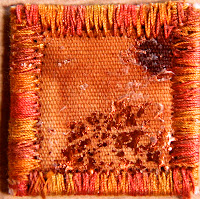 I'm involved in another inchie swap and because everyone is asking for how-to info, I've decided to show you how I made this batch. First, let's look at the supplies...
I'm involved in another inchie swap and because everyone is asking for how-to info, I've decided to show you how I made this batch. First, let's look at the supplies...- Timtex (which is a heavy stabilizer used in baseball caps to form the visor). It is sold in the interfacing section of your craft shop. You will need 5 1/2" by 6 1/2" piece which you will later cut into 1" squares. This size will make 30 squares or "inchies."
- Delta Renaissance Foil sheets in copper (I found them at my local craft shop).
- Bonash 007 Bonding Agent (I found this online at www.embellishmentvillage.com).
- King Tut quilting thread by Superior Thread-color 912 www.superiorthreads.com
- Bottom Line bobbin thread by Superior color 618. www.superiorthreads.com
- Base fabric is rusted fabric. Instructions on the blog earlier.
- Fusible- Steam-A-Seam2 This is important because the fusible needs to be on both sides.
- Washers- 3/4" with small centers (I got mine at Ace Hardware for 11 cents each.)
- Tim Holtz Alcohol Inks. Colors: Terra Cotta, Ginger, Vintage Photo
- Ink applicator (Foam)
- Alene's Tacky Glue (Small bottle with applicator tip)
- Beads (copper seed beads used here)
- I started with a 5 1/2" by 6 1/2" square of Timtex, both sides of which I covered with Steam-a-Seam2 and my rusted fabric. I've given directions on rusting fabric before on this blog (see archives). This must be fused with a hot iron on both sides.
- Next, I foiled the fabric on both the front and the back. I later audition the sides to decide which I want to use for the front. I sprinkle the Bonash (like salt granules) onto the fabric side I chose. I then place the Delta Renaissance Foil sheets, pretty copper side up, over the "salty area" using the tip of my iron and pressing firmly on the foil. Pull away the sheet, and voile', you have copper foiling. I love this look.
- Again I audition the foil sides, select my favorite, and then I am ready to cut the full piece into small 1" squares, using my rotary cutter and mat as it is gridded, which makes it oh-so easy to cut perfectly.
- After the piece has been separated into the smaller pieces, the next step is to satin stitch around all four edges of the individual inches. I am fortunate to have a Bernina 200, which has the 9 mm wide stitch and it is gorgeous. I set the satin stitch to 4.0 wide, using Superior Threads (see above) on top and bottom. My tip here is that I prefer machine satin stitching for this step, although other stitches will work, a plain zigzag, or even stitches done by hand.
5. Let me remind you that I am making 25 inchies for this particular swap. It goes so easy when you are just sating stitching around the edges. And these thread colors go beautifully on the rusted fabric. I usually make 2-3 stitches to finish off and find that if I have any trouble with raveling of the threads, I just pull out my tube of Fray Block and put a single drop on the offending thread and it seals it immediately. With these finished so easily, we are ready to put the washers on the centers.
 6. Tim Holtz alcohol inks are readily available at craft and stamping stores and provide the perfect coloring for our inches. I used 3 colors but you can choose your own color combinations. The inks can be combined or used singly.
6. Tim Holtz alcohol inks are readily available at craft and stamping stores and provide the perfect coloring for our inches. I used 3 colors but you can choose your own color combinations. The inks can be combined or used singly.To add the color to the washers, use the ink applicator with the foam pad. Pounce the applicator into the ink and transfer it onto the washer. Let each layer of ink dry somewhat before pouncing again, or you may find you are simply transferring colors, not applying them. I do use a craft mat under my colors but you may successfully use freezer paper. And I did lay tape under the washers so that they would not move when I was applying the inks. Let them dry thoroughly before using the Tacky Glue to glue them onto the inchies.
7. The finishing touch is copper seed beads that were glued to the surface of the washers.






No comments:
Post a Comment